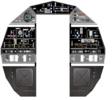After so many attempts at doing the backside of the dish. I give up! I will take the better of the molds I created and make a wee greeble for the extra greebley round end, that seems to be problematic, to be an add-on greeble after shaving off the face on the round greeble, once created.
I found less sticky harder to get details, due to firmness. The lightly sticky gets into the details, but ends up stuck, due to the finest details from 3D printing. Corners and channels are sharp like knives, which help in cutting and breaking away bits that are locked into place. I can do the wee greeble as an imprint with not so sticky mix, and go for a Hasbro look with taming down details. Too much of them with all the new greeble mods will counter the blance of toy and display. I could very well have just painted the dish and other greebles, but wanted toy durability to be primary. The only issue is the quad cannons. Being an amature, I have not enough experience with such intricate complex detail, that requires sectional work to be done to recreate in Hasbro plastic.
Still awaiting the electronics stuffs for cockpit and game area lighting additions. Will be creating one last round of molds and redesigning the bulkhead, soon.
I found less sticky harder to get details, due to firmness. The lightly sticky gets into the details, but ends up stuck, due to the finest details from 3D printing. Corners and channels are sharp like knives, which help in cutting and breaking away bits that are locked into place. I can do the wee greeble as an imprint with not so sticky mix, and go for a Hasbro look with taming down details. Too much of them with all the new greeble mods will counter the blance of toy and display. I could very well have just painted the dish and other greebles, but wanted toy durability to be primary. The only issue is the quad cannons. Being an amature, I have not enough experience with such intricate complex detail, that requires sectional work to be done to recreate in Hasbro plastic.
Still awaiting the electronics stuffs for cockpit and game area lighting additions. Will be creating one last round of molds and redesigning the bulkhead, soon.

